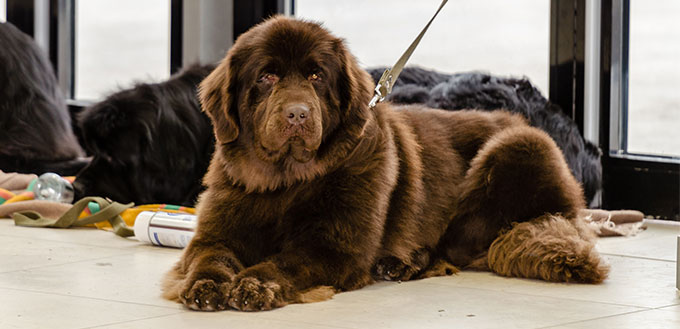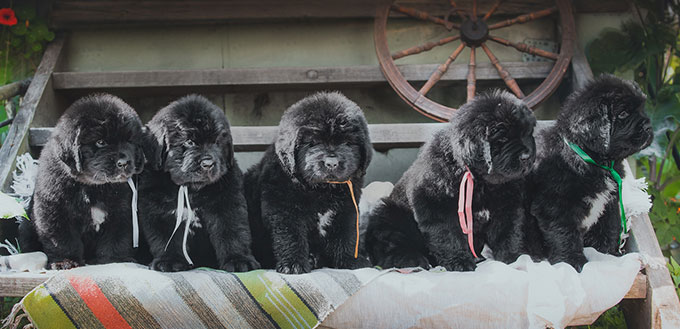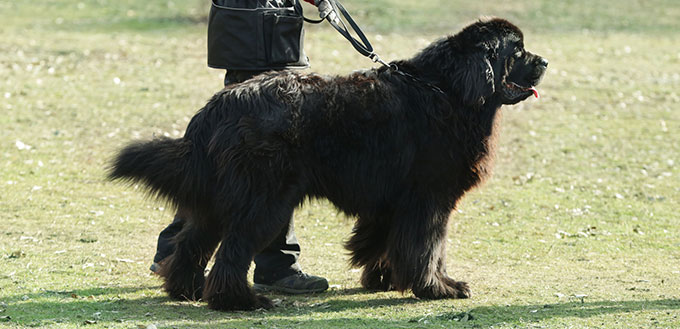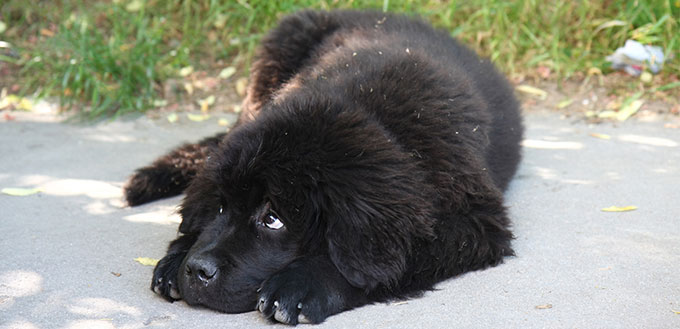A gentle giant, Newfoundland dogs are known for their sweet and loving natures. Originally bred as working dogs for fishing and hauling wood. As well as being strong, they are also good swimmers. Patient and kind to children, these dogs have been nicknamed ‘nannies’. If you are going to invite one of these into your home, you need to be prepared for the individual challenges involved in looking after one. So, here is some more information to help you in your task.

History of the Newfoundland Dog Breed
With some dogs, the history goes back so far that we cannot be 100 percent certain about it. But some people believe that their ancestors were left by the Vikings when they visited the New World way back in 1000 A.D. and bred with local wolves. Over the years, they became useful companions in fishing and transportation, known particularly for their dramatic water rescues.
English botanist Sir Joseph Banks acquired several in the late 18th century. The breed was officially identified and described by Professor Albert Heim of Switzerland. But at the end of the 18th century, the breed was almost tragically wiped out when the Canadian government introduced a system of high taxation on the one dog they could keep. Painter Sir Edwin Landseer featured some in his paintings, which helped with their resurgence.
The first one was shown in England in 1860 and it was registered with the American Kennel Club in 1879. In the early 20th century, the governor of Newfoundland made the dog his breed of choice.
Who are the Parents (Only When It Is Mixed Breed)
There are different theories about how Newfoundland dogs came into existence. They could be a cross between a Tibetan Mastiff and the extinct American Black Wolf. Alternatively, they could be crossbred from Pyrenean Sheep Dogs, Portuguese Water Dogs, and Mastiffs.
Quick Facts
Newfoundland dog weight should be between 100 and 150 pounds. They stand up to 28 inches tall. Their coat colors include brown, black, gray, and black and white.
A typical Newfound dog life span is between 8 and 10 years.
Sharing a birthplace with the popular Labrador Retriever, these breeds share many similar characteristics including intelligence, work ethic, and a willingness to please human beings.
These dogs are known for their strong swimming abilities thanks to their webbed feet. They can even save grown men from drowning and are still known as the number one rescue dog in the world.
Dealing with the icy North Atlantic, they used to haul fishing nets to shore and haul fishing nets to shore.
A Newfoundland called Seaman was part of the exhibition who joined Lewis and Clark when they trekked 8000-miles across the American continent.
The famous Romantic poet Lord Byron had his own beloved Newfie who he erected a statue for at his former home of Newstead Abbey.
Another way that the dog was immortalized was in J.M. Barrie’s classic Peter Pan novel, where ‘Nana’ acted as a babysitter!

Things You Should Know
There are a few things that you should know before getting a Newfoundland Mastiff. Some of the more complex challenges revolve around ensuring that your pooch is properly groomed, as well as possible health complications involves in adopting a dog of this size. So, here is a guide on some of the key issues which you will need to confront.
Training
As these are dogs who were bred to work closely alongside humans, they are good for training purposes. If you are going to train your dog for water work, you can start this when they are as young as four months old. You are better off training them in a gentle way as you are less likely to get positive responses if you attempt a method of harsh corrections. But if you keep your methods kind and consistent, you should achieve good results.
Similar to other dogs, you should begin training early as this is how you are more likely to achieve success. Also, you are going to struggle to move your dog anywhere when they are fully grown, so vocal commands will be essential!
Feeding
Feeding your Newfie dog a high-quality diet is important in maintaining their health. While these are big hounds, you still need to ensure that you don’t feed them too much as obesity is dangerous. And while treats can be useful training aids, too many are not good for your dog. It is always worth learning more about the type of human food that is and isn’t suitable for pooches as many people like to give their canines leftovers.
You should bear in mind that this breed can suffer from bloat, which is a potentially life-threatening condition that causes the stomach to distend and twist. Some of the possible ways of preventing it include offering several small meals a day and preventing too much vigorous exercise around mealtimes. Having structured mealtimes also gives you the benefit of knowing how much your dog eats on a regular basis, so you know if they experience any loss of appetite.
If you go down the path of a dry food diet, you can expect to give them around four or five cups of it every day. But the amount that your dog requires depends on a number of unique factors such as the Newfoundland dog size, build, age, activity level, and metabolism rate. You can give your dog a simple visual inspection to see if they have put on any weight. You should be able to see their waist. When you feel your dog, you should be able to feel their ribs without pressing particularly hard.
Grooming
Newfoundland dog breeds have flat, heavy, and water-resistant coats that helped them survive in the cold climate of Canada, so you should get into the habit of brushing it at least once a week. The outer coat is long and coarse, while the undercoat is dense and soft Use a slick brush and a long-toothed comb and this will help to prevent mats and remove dead hair. Shedding season occurs twice a year during the spring and fall months, and this is when you need to up grooming sessions to a daily basis. However, Newfs who have been spayed or neutered will need more regular brushing as they shed all year round. Either way, you are probably going to have to do a lot of vacuuming around the house! On a side note, this is a dog who drools a lot, so you can expect to clean up plenty of slobber!
You should also get into the habit of trimming your dog’s nails on a regular basis. If you hear their nails clacking on the ground, they have gotten too long. Overly long nails can be uncomfortable for your four-legged friend. Be careful when you are undertaking this task as their toenails have blood vessels inside, so you can cause bleeding if you cut too far.
You should also brush your dog’s teeth weekly to prevent gum and periodontal issues from arising. Daily is even better if you really want to stave off periodontal disease. This may take a bit of getting used to for both of you, but it is certainly worth persevering with. As these are drop-eared dogs, you should check their ears for any signs of infection. You shouldn’t need to put anything in their ear canal – cleaning the outer ear is enough.
You shouldn’t have to bathe your dog often – every one or two months is to be expected. However, the coat of this hound is a magnet for dirt, so you may have to bathe them more often if they roll around in the mud or worse. But as these are such huge dogs, many people decide that enlisting the help of a professional groomer is the best course of action.

Health
There are a few conditions that Newfoundland dogs are more at risk of including hip and elbow dysplasia, cystinuria, and cardiac diseases. If you are planning on buying Newfoundland puppies from a breeder, you should obtain health clearances for both parents. You should expect these to cover all the conditions that we have just mentioned.
Exercising your pooch regularly is an important part of maintaining their wellbeing. As this was traditionally a working dog who was used to getting a lot of physical activity, you should count on giving your dog at least half an hour of moderate exercise per day if they are not working. They enjoy a host of activities including swimming and hiking. They could even make a great hiking companion on your next exhibition. As well as this, they can participate in a host of canine escapades such as agility, flyball, obedience, and tracking.
Traditionally, these are cold weather dogs, but they can also adapt to warmer conditions as well. However, you need to take steps to protect your pooch from heatstroke. When the weather gets particularly warm, you should use air conditioning and fans appropriately.
Temperament
Known for their sweet nature, the Newfoundland dog temperament has been likened to cuddly teddy bears. When they are introduced into a family, they quickly develop a loving attachment. And this means that you shouldn’t leave your dog alone for long periods of time or leave them in your backyard or a kennel.
Like all dogs, you need to ensure that you properly socialize your pooch, which means exposing them to lots of sights, sounds, experiences, and people. If you do this at a young age, you will help this social nature to continue long into the future. There are several ways of doing this including enrolling your dog in puppy kindergarten, taking them out to busy parks, and inviting visitors over. As long as they are properly socialized, they can also get along with smaller animals like cats.
While these are big dogs, they like being inside with their families for long periods of time. Daily contact is essential. These are curious and bold creatures who you wouldn’t expect to act in a timid or skittish manner. At the same time, you wouldn’t expect your dog to act aggressively. J.M. Barrie’s depiction of child-loving pooch Nana in Peter Pan was quite an accurate portrayal. As well as being gentle and friendly towards children, they are often highly protective, and many parents feel very safe when their Newfie is around. However, you still need to teach your kids to interact with your dog properly. For example, they should only play with their Newfie at certain times during the day – and this is never when eating or sleeping.
If you get a dog who doesn’t have the right sort of temperament, you may experience some difficulty. After all, for many people, this is a dog who outweighs them, and there are bound to be some inevitable challenges from this fact alone!

Final Thoughts
There is a lot to love about Newfoundland dogs – quite literally! While these are huge pooches, their nature is loving and gentle. Of course, you need to have a home that is big enough and be prepared for their high grooming needs. You should also ensure that your dog is properly trained. But if you prepare yourself properly, whether you get your dog for working purposes or for companionship, they can do either job admirably.
There are several different ways that you can obtain your Newfoundland dog, but you should never buy from an irresponsible breeder. Alternatively, you could find a shelter dog or get one from a rescue center. And if you do decide to go down the path of going to a dog breeder, you should always choose a reputable one. You want a dog with a nice temperament and one that is free of genetic diseases. Try to get personal recommendations, ask questions, and check documentation until you are happy.
You may also like our other breed guides on the: Black Mouth Cur, Mi-Ki Dog, Biewer Terrier and Bernedoodle
More Pet Product Reviews
Vacuum for Pet Hair
Dog Beds
Dog Water Fountains
Dog Bowls
Electronic Dog Doors
Dog Monitors
Dog Crate Covers
Dog Baskets For Bikes
Raised Dog Beds
Source:
- Newfoundland, VCA Hospitals






